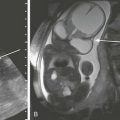Imaging Techniques
Imaging Technique Overview
In the setting of acute trauma, nonarticular long bones should be imaged with at least two views (frontal and lateral). Osteoarticular regions should be imaged with three views (frontal, lateral, and oblique). Dedicated imaging of the digits is preferred rather than general imaging of an entire hand or foot when a patient has a single symptomatic digit. The radiograph should be the initial screening tool before computed tomography (CT) or magnetic resonance imaging (MRI) is performed in the setting of acute injuries. For alignment disorders, including scoliosis and foot deformities, weight-bearing views should be obtained routinely. In cases of suspected child abuse, a dedicated skeletal survey should be performed. Bone scintigraphy and MRI are complementary tools in the evaluation of child abuse, but they may miss the classic metaphyseal corner fracture.1
Magnetic Resonance Imaging
Postcontrast sequences are useful for determining tumor vascularity, defining granulation tissue versus abscess in the setting of infection, and evaluating the synovium. Normal noninflamed synovium eventually enhances and should not be mistaken for pathology.2 The relative thickness of the synovium as depicted by contrasted sequences is what is important in the setting of a joint effusion if pyogenic or nonpyogenic inflammatory arthritis is suspected. When initial precontrast images are entirely normal, postcontrast images have limited additional value.
References
1. Offiah, A, van Rijn, RR, Perez-Rosello, JM, et al. Skeletal imaging of child abuse (non-accidental injury). Pediatr Radiol. 2009;39:461–470.
2. Ejbjerg, B, Narvestad, E, Rostrup, E, et al. Magnetic resonance imaging of wrist and finger joints in healthy subjects occasionally shows changes resembling erosions and synovitis as seen in rheumatoid arthritis. Arthritis Rheum. 2004;50(4):1097–1106.




